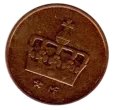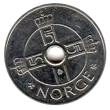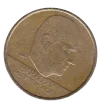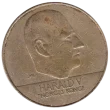Exchange your Norwegian Kroner
Do you have leftover Norwegian Kroner? We offer a fast and easy way to exchange both current and withdrawn Norwegian Kroner banknotes and coins. Convert them into your local currency today with our quick and hassle-free exchange service.
kr - NOK
The Norwegian Krone has been in use since 1875 and continues to play a central role in supporting Norway’s economy, particularly in the energy and export sectors.
Norwegian Kroner Information
The Norwegian Krone (NOK) is the official currency of Norway and is one of the most stable currencies in the world.
Introduced in 1875, the Norwegian Krone replaced the speciedaler as part of Norway’s entry into the Scandinavian Monetary Union. The name “krone,” which means “crown” in Norwegian, reflects the tradition of naming currencies after monarchies. The Krone remains an important symbol of Norway’s sovereignty and economic strength.
The Norwegian Krone is subdivided into 100 øre, and the currency is issued in both coins and banknotes. Coins are available in denominations ranging from 1 krone to 20 kroner, while banknotes are issued in denominations of 50, 100, 200, 500, and 1,000 kroner. The designs on Norwegian banknotes often feature prominent national figures, cultural icons, and natural landmarks, including images of famous Norwegians such as Edvard Munch and Fridtjof Nansen, as well as depictions of Norway’s stunning fjords and wildlife.
Norway’s economy is largely driven by its vast natural resources, particularly oil and gas. The stability of the Norwegian Krone is crucial for maintaining the country’s economic resilience, as Norway is a major exporter of energy to countries around the world. In addition to energy, Norway’s economy also benefits from sectors such as shipping,
fishing, and technology. The Krone plays a key role in supporting Norway’s international trade and investment.
The central bank of Norway, Norges Bank, is responsible for issuing the Norwegian Krone and managing the country’s monetary policy. The bank’s primary objectives are to maintain price stability, control inflation, and promote a stable financial system. Norges Bank also plays a crucial role in regulating the value of the Krone, ensuring that it remains stable amid fluctuations in the global economy. The Krone is a freely floating currency, meaning its value is determined by market forces.
One of the unique aspects of the Norwegian Krone is its strong link to Norway’s oil exports. The Krone’s value is often influenced by global oil prices, as Norway is one of the world’s leading oil producers. This makes the Krone sensitive to fluctuations in commodity markets, although the Norwegian government has implemented strategies to mitigate the impact of these fluctuations on the wider economy.
In conclusion, the Norwegian Krone has been the official currency of Norway for over a century and remains a symbol of the country’s economic strength and independence.
It plays a vital role in supporting Norway’s international trade, particularly in the energy sector, and continues to be a trusted and stable currency on the global stage.















